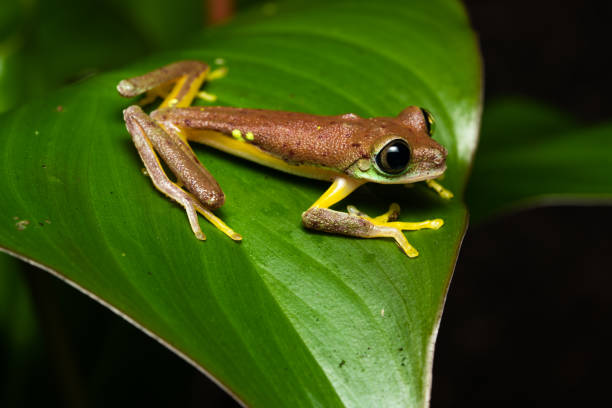ANIMAL: Lemur Leaf Frog Agalychnis lemur Type of Animal: Frog Habitat: Humid forest Location(s): Costa Rica, Panama, NW Colombia Appearance: Vibrant green frog changes to brown at night, slender-bodied frog, orangish feet, big white eyes Food/Diet: Insects, worms, snails Status in Wild: Critically Endangered Conservation: Breeding in zoos, aquariums, & herpetoculture. Costa Rican Amphibian Research Center introduces captive-bred tadpoles to artificial ponds. El Valle Amphibian Conservation center working w/ populations in Panama. Project Lemur Frog started in 1999 at Manchester Museum’s Vivarium. Introductions of captive-bred animals into wild. Lifestyle: Groups of 2-10 Additional Info: Called: Male Female Young: Tadpole Group: Army Weight: Male: 0.07 oz Female: 0.14 oz Gestation: 2 weeks Life Span: 5-10 years Body Length: Male: 1.18-1.57 in Female: 1.57-1.96 in Critically endangered due to chytrid fungus, diseases, habitat loss, habitat fragmentation, deforestation, pet trade, & pollution, medicinal research, & climate change. Also called lemur frog or lemur tree frog. Active at night (nocturnal). Females lay 2-3 clutches a night in breeding periods. Each clutch has 10-30 eggs. Eggs deposited on leaf surfaces/undersides hanging over water. Tadpoles metamorphose into froglets at 40-150 days. Some tadpoles metamorphose before others. Adulthood reached at 1-1.5 years. Males begin courtship by calling/singing to attract females. Big eyes useful for seeing at night. Coloration aids in camouflage. These frogs move very slowly, walking hand over hand, only jumping when fleeing from danger. Males guard tiny territories at breeding time, calling w/ short “ticks.” Breed most often in rainiest periods. Males use nuptial pads to clasp onto females when breeding. There may be less than 500 mature frogs left in the wild. Fun Fact(s): These frogs are very sensitive & delicate. Have use in medical research due to skin peptides. There’s speculation that the Costa Rican population may be a separate subspecies or even species from the Panamanian/Colombian population. These frogs can bask in sun for extended time periods w/o drying out due to skin pigment (pterorhodin) reflecting heat off skin surface.
